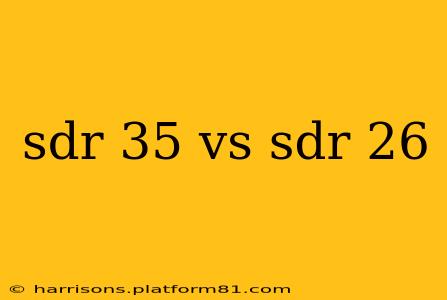SDR 35 vs. SDR 26: A Comprehensive Comparison for Choosing the Right Solution
Choosing between the SDR 35 and SDR 26 depends heavily on your specific needs and application. Both are high-quality SDR (Software Defined Radio) devices, but they cater to different user profiles and functionalities. This comparison will help you understand the key differences and make an informed decision.
Understanding SDRs: A Quick Overview
Before diving into the specifics, let's clarify what SDRs are. Software Defined Radios utilize software to process radio signals, offering flexibility and adaptability unmatched by traditional hardware-based radios. They can be programmed to receive and transmit across a wide range of frequencies, making them versatile tools for various applications like amateur radio, spectrum monitoring, and research.
Key Differences: SDR 35 vs. SDR 26
While both are capable devices, the SDR 35 and SDR 26 possess distinct features targeting different user segments and applications. The major differences typically revolve around:
-
Frequency Range: This is perhaps the most significant difference. The SDR 35 usually boasts a wider frequency range than the SDR 26, allowing it to cover more spectrum. Check the specifications of the particular models as the exact ranges can vary between manufacturers and specific versions.
-
Sampling Rate: A higher sampling rate translates to better fidelity and the ability to capture finer details in the signal. The SDR 35 typically offers a higher sampling rate, leading to improved performance in certain applications.
-
Dynamic Range: This refers to the difference between the strongest and weakest signals the receiver can handle without distortion. A higher dynamic range is generally preferable, especially when dealing with weak signals. Again, this can vary between specific models and manufacturers.
-
Power Consumption: Power requirements are often higher for the SDR 35 due to its greater capabilities. This is a significant consideration for portable applications.
-
Software Support and Ecosystem: Both devices will likely have software support, but the community size and available features might vary. A larger community often translates to better support and more third-party tools.
-
Price: Generally, the SDR 35, with its superior capabilities, will command a higher price point than the SDR 26.
H2: Which SDR is Right for Me?
The choice between the SDR 35 and SDR 26 hinges on your individual needs:
-
Choose the SDR 35 if: You require a wider frequency range, a higher sampling rate, and superior dynamic range. You're working on projects needing high-fidelity signal capture and processing, or if you anticipate needing to work across a broad spectrum of frequencies. You're willing to pay a premium for enhanced performance.
-
Choose the SDR 26 if: Your application doesn't necessitate the extreme performance capabilities of the SDR 35. Budget is a significant constraint, and you require a simpler, more affordable solution.
H2: What are the common applications of SDR 35 and SDR 26?
Both SDR 35 and SDR 26 find application in various fields. Examples include:
- Amateur Radio: Both are suitable for amateur radio enthusiasts, though the SDR 35 offers more flexibility for advanced applications.
- Software Defined Radio Development: Both can be used for educational purposes and in prototyping applications related to SDR development.
- Spectrum Monitoring: Both can be used for simple spectrum monitoring, but the greater range of the SDR 35 could be beneficial for more comprehensive surveillance.
- Research and Development: For research involving radio frequency signals, the more advanced features of the SDR 35 often make it the preferred choice.
H2: What are the limitations of SDR 35 and SDR 26?
While powerful tools, both SDRs have limitations:
- Software Dependence: Their functionality depends entirely on software, and any software glitches can impact performance.
- Complexity: Setting up and using SDRs can be more complex than using traditional radios.
- Potential for Interference: External interference can affect signal reception.
H2: Where can I find more information about specific SDR 35 and SDR 26 models?
To find precise specifications and pricing, you'll need to consult the manufacturer's website for the specific SDR 35 and SDR 26 model you're interested in. Remember that different manufacturers may offer devices with these designations but with slightly different specifications. Always check the technical details before purchasing.
This comparison provides a general overview. The specifics of any given SDR 35 and SDR 26 model will vary depending on the manufacturer and version. Always consult detailed specifications before making a purchase to ensure it meets your precise needs.
